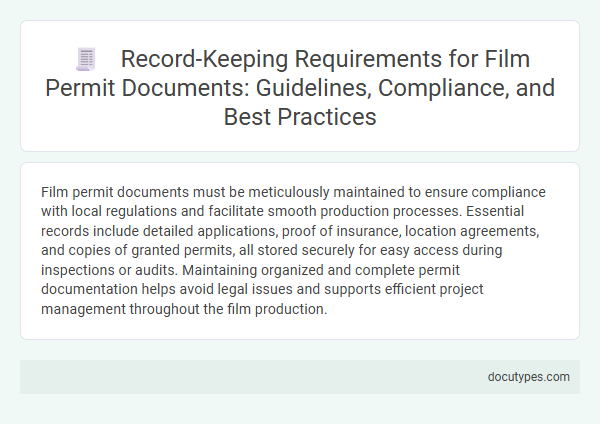Film permit documents must be meticulously maintained to ensure compliance with local regulations and facilitate smooth production processes. Essential records include detailed applications, proof of insurance, location agreements, and copies of granted permits, all stored securely for easy access during inspections or audits. Maintaining organized and complete permit documentation helps avoid legal issues and supports efficient project management throughout the film production.
Introduction to Film Permit Record-Keeping
Film permit record-keeping is essential for maintaining compliance with local regulations and ensuring smooth production processes. Proper documentation includes applications, approvals, correspondence, and proof of permit adherence. Understanding these requirements helps you manage and store film permit records efficiently for future reference and audits.
Legal Framework for Permit Documentation
Film permit documentation must adhere to strict legal frameworks to ensure compliance with local, state, and federal regulations. Proper record-keeping of these documents is essential to protect production teams and facilitate regulatory audits.
- Statutory Compliance - Film permits must comply with laws governing location use, safety protocols, and environmental impact assessments.
- Retention Periods - Legal frameworks often mandate retaining permit records for a specific number of years to support accountability and potential legal review.
- Accessibility and Security - Recorded film permit documents must be securely stored yet readily accessible to authorized officials for inspection or legal proceedings.
Maintaining organized and compliant film permit records helps avoid legal disputes and ensures smooth production operations.
Types of Documents Required for Film Permits
Film permit applications require thorough documentation to ensure compliance with local regulations. Knowing the types of documents needed helps streamline the approval process.
- Location Agreement - A signed contract or permission from property owners confirming filming rights on the specific site.
- Proof of Insurance - Documentation demonstrating liability coverage protects against potential damages or accidents during filming.
- Detailed Script or Shooting Schedule - Provides authorities with information about the scenes, timing, and activities planned to manage public safety and logistical concerns.
Essential Guidelines for Record Management
| Record-Keeping Requirement | Essential Guidelines |
|---|---|
| Retention Period | Maintain film permit documents for a minimum of 3 to 7 years in compliance with local regulations and audit requirements. |
| Document Types | Include all applications, approvals, correspondence, agreements, insurance certificates, and any amendments related to the film permit. |
| Storage Format | Store documents in both physical and digital formats. Use secure, indexed filing systems to ensure easy retrieval and protection against loss or damage. |
| Access Control | Limit access to authorized personnel only. Implement authentication and audit trails for digital records to maintain confidentiality and integrity. |
| Compliance and Audits | Regularly review record management practices to ensure compliance with government and industry regulations governing film permits. |
| Backup and Disaster Recovery | Create secure backups of digital records and store them offsite or in cloud environments to mitigate risks of data loss. |
| Record Disposal | Destroy records securely after the retention period using shredding or certified data wiping methods to prevent unauthorized access. |
Storage and Security of Permit Records
Proper storage and security of film permit records are essential to maintain compliance with legal and regulatory standards. These documents must be stored in a secure location, protected from unauthorized access, damage, or loss.
Digital copies should be encrypted and backed up regularly to ensure data integrity. You must implement access controls and retain records for a period defined by local regulations, typically several years.
Retention Periods for Film Permit Documents
What are the record-keeping requirements for film permit documents? Film permit documents must be retained to ensure compliance with local regulations and to provide evidence of authorized filming activities. Retention periods typically range from three to seven years, depending on jurisdiction and agency guidelines.
Digital vs. Paper Record-Keeping Methods
Film permit documents must be carefully maintained to ensure compliance with local regulations and enable quick verification during production. Understanding the differences between digital and paper record-keeping methods is crucial for efficient management.
Digital record-keeping offers advantages like easy access, secure backup, and faster retrieval compared to traditional paper files. Electronic databases enable centralized storage, reducing the risk of document loss due to physical damage or misplacement. However, paper records remain valuable as legal proofs in certain jurisdictions and provide a tangible backup in case of technical failures.
Compliance Standards and Regulatory Audits
Film permit documents must be maintained in strict accordance with local and state compliance standards to ensure legal operation and accountability. These records are routinely examined during regulatory audits to verify adherence to all permit conditions and safety protocols.
- Retention Periods - Your film permit documents should be kept for a minimum of three to five years, depending on jurisdictional requirements to meet audit standards.
- Accessibility - Records must be organized and readily accessible for inspection by regulatory bodies to facilitate efficient audit processes.
- Accuracy and Completeness - Documentation should comprehensively capture all permits, related correspondence, and approvals to demonstrate full regulatory compliance.
Common Pitfalls and How to Avoid Them
Record-keeping requirements for film permit documents mandate accurate and organized storage of all permits, insurance certificates, and related correspondence to ensure compliance with local regulations. Common pitfalls include misplacing documents, incomplete filing, and failure to update records promptly, which can result in fines or production delays. To avoid these issues, implement a centralized digital filing system with regular audits and clear version control protocols.
What Are the Record-Keeping Requirements for Film Permit Documents? Infographic

